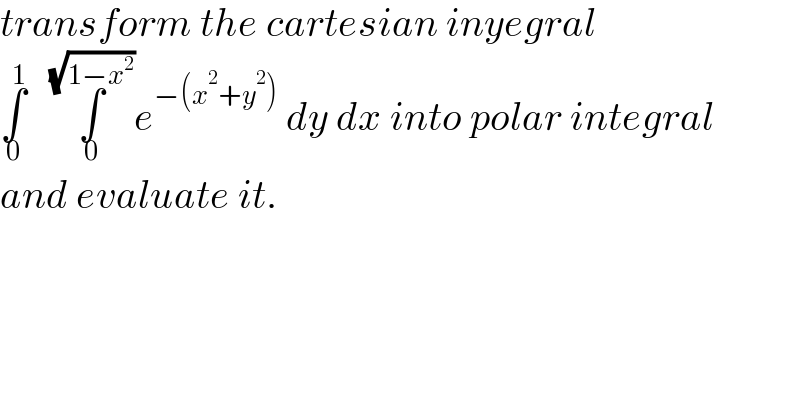
Question and Answers Forum
Question Number 146067 by gsk2684 last updated on 10/Jul/21

Answered by Olaf_Thorendsen last updated on 10/Jul/21
![A = ∫_0 ^1 ∫_0 ^(√(1−x^2 )) e^(−(x^2 +y^2 )) dydx x = rcosθ, y = rsinθ dS = dydx = rdrdθ A = ∫_0 ^(π/2) ∫_0 ^1 e^(−r^2 ) rdrdθ A = (π/2)[−e^(−r^2 ) ]_0 ^1 = (π/2)(1−(1/e))](Q146068.png)
Commented by gsk2684 last updated on 11/Jul/21
![thank you sir ∫_0 ^(Π/2) [((−e^(−r^2 ) )/2)]_0 ^1 dθ = ((−1)/2)∫_0 ^(Π/2) (e^(−1) −1)dθ =((−1)/2)((1/e)−1)((Π/2))=(Π/4)(1−(1/e))](Q146078.png)
| ||
Question and Answers Forum | ||
Question Number 146067 by gsk2684 last updated on 10/Jul/21 | ||
 | ||
Answered by Olaf_Thorendsen last updated on 10/Jul/21 | ||
![A = ∫_0 ^1 ∫_0 ^(√(1−x^2 )) e^(−(x^2 +y^2 )) dydx x = rcosθ, y = rsinθ dS = dydx = rdrdθ A = ∫_0 ^(π/2) ∫_0 ^1 e^(−r^2 ) rdrdθ A = (π/2)[−e^(−r^2 ) ]_0 ^1 = (π/2)(1−(1/e))](Q146068.png) | ||
| ||
Commented by gsk2684 last updated on 11/Jul/21 | ||
![thank you sir ∫_0 ^(Π/2) [((−e^(−r^2 ) )/2)]_0 ^1 dθ = ((−1)/2)∫_0 ^(Π/2) (e^(−1) −1)dθ =((−1)/2)((1/e)−1)((Π/2))=(Π/4)(1−(1/e))](Q146078.png) | ||